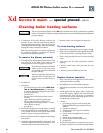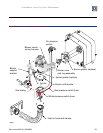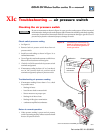
61Part number 550-141-850/0699
• Installation • Start-Up • Parts • Maintenance
Expansion tank
1. Expansion tanks provide space for water to move in and out as the heating system water
expands due to temperature increase or contracts as the water cools. Tanks may be open-,
closed- or diaphragm- or bladder-type. See Section III of this manual for suggested best
location of expansion tanks and air eliminators.
Open-type — Located above highest radiator or baseboard unit, usually in the attic or
closet. Has a gauge glass and overflow pipe to a drain.
Closed-type — Welded gas tight and located above boiler. Tank is partially filled with water,
leaving an air cushion for expansion.
• Make sure this type of tank is fitted with a tank fitting, such as the B & G Tank-Trol
or Taco Taco-Trol. This fitting reduces gravity circulation of air-saturated tank water
back to the system and prevents the air from bubbling up through the water as it
returns from the system.
• Do not use automatic air vents in systems with closed-type tanks. The air
will escape from the system instead of returning to the tank. Eventually, the tank will
waterlog and no longer control pressurization. The boiler relief valve will weep
frequently.
Diaphragm- or bladder- type — Welded gas tight with a rubber membrane to separate
the tank pressurizing air and the water. May be located at any point in the system, but most
often found near the boiler.
• Systems with this type of expansion tank require at least one automatic air vent,
preferably located on top of an air eliminator, as shown in examples in manual
Section III.
2. If relief valve has tended to weep frequently, the expansion tank may be waterlogged or
undersized.
Closed-type tank — Tank is most likely waterlogged. Install a tank fitting if not already
installed. Then check fill level per fitting manufacturer’s instructions. If fill level is correct,
check tank size against manufacturer’s instructions. Replace with a larger tank if necessary.
Diaphragm- or bladder type — First, check tank size to be sure it is large enough for the
system. If size is too small, add additional tank(s) as necessary to provide sufficient expansion.
If tank size is large enough, remove tank from system and check charge pressure (usually 12
psig for residential applications). If tank won’t hold pressure, membrane has been damaged.
Replace tank.
Annual start-up —
check/test
Observation port
85034
Gauges
1. Boiler pressure/temperature
gauge — Inspect gauge and check
whether readings are reasonable.
Replace if any signs of leakage
from case or improper readings.
2. System gauges (if installed) —
Inspect and check readings of
other gauges in system.
Igniter
1. Verify igniter operation — Look
through blower observation port
(see Figure 29). Access the blower
by removing the boiler jacket
front panel if not already
removed.
Figure 29 Igniter observation port in blower


















